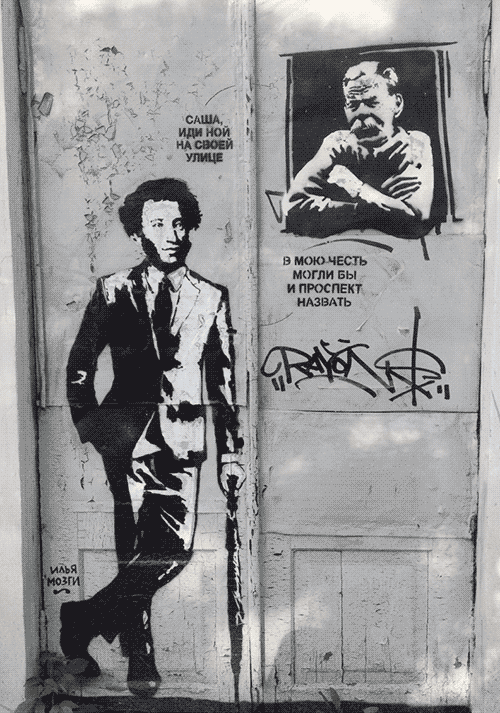Has “Springtime for Hitler” finally met its match?
What, after all, could be a better example of bad taste than a figure-skating routine performed by a man and a woman dressed as concentration camp inmates, complete with stripes and yellow stars? Clearly, Mel Brooks chose the wrong season for his Hitler-themed broadway scam. Winter is coming, accessorized with Holocaust kitsch.
Last Saturday’s episode of “Ice Age” (which the New York Times describes as a “celebrity ice-dancing show on Russian television”) hit a particular viral sweet spot: part “wacky Russian” YouTube video (like the dash cam videos popularized by Jon Stewart after the Chelyabinsk meteor), part Putinist horror story (former Olympic ice skater Tatiana Navka is married to presidential spokesman Dmitry Peskov).
The response in the West is unsurprising and understandable. The comedian Sarah Silverman put it best when she tweeted, “Oh those whacky Holocaust victims (OH MY GOD OH MY GOD OH MY GOD).” And this is from someone who, just last spring, scandalized the bourgeoisie by making jokes about abortion and semen at a children’s education charity gala. Successfully shocking Sarah Silverman is a feat of Olympic proportions.
But there’s a funny thing about taste, both good and bad: it’s not universal. Taste is all about context, culture, values, and power. So the real question is: how could something be so widely applauded in one country and reviled in another?
Life Is Beautiful, but Film is Tacky
Before we address the taste gap, we must give credit (or blame) where it is due: Navka’s dance routine was inspired by Roberto Benigni’s 1997 Life Is Beautiful, an Oscar-winning comedy set in a concentration camp. Benigni plays an Italian Jew who helps his young son cope with the Holocaust by pretending that the camp is a complex game, before finally sacrificing his life to save his family.
Critics (and audiences) were divided: was this a charming way of making the Holocaust “real” again through the device of make-believe? Ot was it just in really poor taste? Navka’s performance on “Ice Age” inherits this ambiguity while presupposing unanimity: in adapting Life Is Beautiful, Navka and her partner are clearly convinced of the movie’s power and importance.
The taste gap highlighted by “Ice Age” is a predictable phenomenon when two mass cultures collide, especially when these cultures are not on equal footing. Thanks to America’s continuing global dominance in the entertainment industry, Russian viewers are highly proficient in the codes and tropes of American mass culture, while viewers in the U.S. haven’t the faintest notion of what works (or fails) in Russia. This makes Russian entertainment much more vulnerable to a perception of freakishness or “backwardness.”
Take, for example, the 2009 rediscovery of Soviet crooner Eduard Khil, who became a viral sensation as the “Trololo Man.” Khil’s fame in the West was based entirely on the perception that his performance was ridiculous and cringeworthy. But when I’ve raised this point with education Russian scholars of my generation, my interlocutors seem completely stunned: Ridiculous? I though it was happy and kind of sweet.
Medium and Message
Still, much more is at stake when dealing with the Holocaust. And much less is at stake when it’s a matter of ice dancing. Or is there?
Twenty-five years after the Soviet collapse, Russia is still the heir to a distinct set of artistic traditions that makes “Ice Age” understandable. In the first decades of the USSR’s existence, art was expected to carry a heavy ideological burden. And not just verbal art, which is presumably well-suited for conveying messages—ideology found its way into unlikely art forms. Yale graduate student Mina Magda recently posted on Facebook a particularly striking quote from a Soviet-era article on ballet that illustrates just how far this could go:
“Odette dances the aspiration toward freedom, the heroine of Native Fields has to express in dance the desire that her fiancé will arrive to construct an electric power station in the native kolkhoz.”
By comparison, an interpretive ice dance based on Life Is Beautiful looks easy.
Whose Holocaust is it, Anyway?
At the heart of the controversy is, of course, the Holocaust itself. To many in the West, addressing the Holocaust in an ice dancing competition is nigh on blasphemous. The Russian audience is not composed of Holocaust deniers and Nazi apologists. Why aren’t they outraged?
We should recall that the Holocaust does not loom as large in Russian culture and historiography as it does in America and Western Europe. This is partly because the Soviet downplayed the specifically anti-Jewish persecution involved, but I would say that this is a minor point.
More important is that, for Russia, the Holocaust is only part of a larger narrative: the tragedy that befell Europe in general and the Soviet Union in particular during World War II. With Soviet casualties estimated at 20 million (some of whom are also counted in Holocaust statistics), it is Russia’s suffering that occupies center stage. In the West, the Holocaust is the first thing we think of when we think of Nazis. In the former Soviet Union, it is the German invasion of the USSR.
The Holocaust in the West is both sacred and vexed; sacred, in that its memory is all but untouchable in the public sphere, and vexed, in that the persistence of Holocaust denial by the lunatic fringe requires vigilance about historical memory. In Russia, that same vexed and sacred space is occupied by the Soviet victory. The defeat of Nazi Germany is the primary story unifying virtually the entire population of the Russian Federation, and anything that smacks of revisionism (justified or not) is subject to public attack.
The independent station TV-Rain nearly had to shut down after polling its viewers about the wisdom of remaining in Leningrad during the blockade. Just two days ago Culture Minister Vladimir Medinsky condemned any efforts to revisit the accounts of the Panfilov Division's defense of Moscow or the martyrdom of Zoya Kosmodemyanskaya: "[T]hose who question dig, or try to cast doubt on the accomplishments of our ancestors," he declared, should "burn in hell."
The public commemoration of the Soviet Union’s (and, subsequently, Russia’s) triumphs and tragedies has rarely embraced restraint as its primary aesthetic principle. If an event is worthy of acknowledgment, then it can (and should) be acknowledged by all, in every art form available (remember the opening ceremonies of the 2014 Winter Olympic in Sochi).
So when Westerns (myself included) cringe at “Ice Age,” we should remember: we are not the intended audience.



